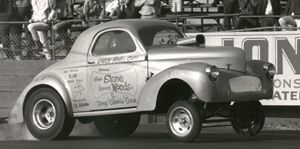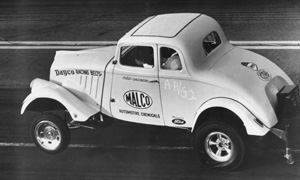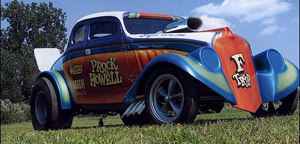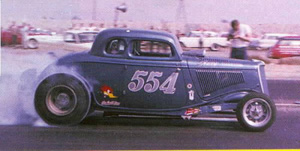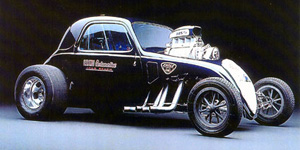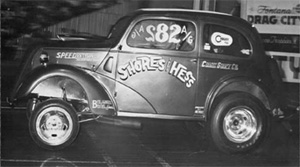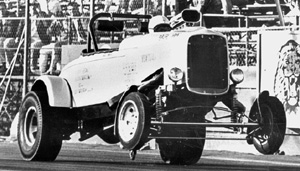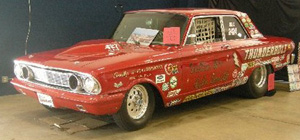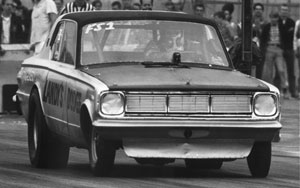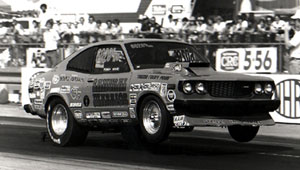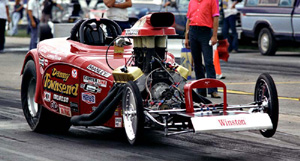

Favorite Race Car Ever voting: Early Door Cars/Roadsters
|
|
||
|
|
||
|
|
||
|
|
||
|
|
||
|
|
||
|
|
||
| Final results for all-time favorite early doorcar/roadster/altered | ||
| Stone, Woods and Cook Willys |
1030
|
(27.06%) |
| Sox & Martin Barracuda |
646
|
(16.97%) |
| Bill Jenkins '68 Camaro |
574
|
(15.08%) |
| Mooneyham & Sharp 554 coupe |
367
|
(9.27%) |
| “Ohio George” Montgomery Willys |
235
|
(6.17%) |
| Don Carlton Motown Missile |
202
|
(5.31%) |
| Gas Ronda Thunderbolt |
176
|
(4.62%) |
| Prock and Howell "F" Troop Willys |
152
|
(3.99%) |
| Dick Landy Dodge Dart |
131
|
(3.44%) |
| Ratican-Jackson-Stearns Fiat |
95
|
(2.50%) |
| Danny Townsend bantam roadster |
81
|
(2.13%) |
| Shores & Hess Anglia |
52
|
(1.37%) |
| Hugh Tucker '28 Chevy AA/SR |
37
|
(0.97%) |
| Terry Hoard Samurai Warrior Mazda |
28
|
(0.74%) |
|
Total Votes: 3806
|
||
|
|
||
|
|
||
|
|
||
|
|
||
|
|
||
|
|
||
|
|
||
Welcome, race fans and column readers, to the next round in our Favorite Race Car Ever balloting. We kicked off this ambitious project a few weeks ago with a call for nominees, and I was not disappointed. The width and breadth of your selections has been breathtaking, as have the memories you have shared.
On Wednesday, we began the first voting with Exhibition Cars, and as I prepare this Friday morning, more than 2,600 votes have been cast. Some clear favorites have emerged, but because balloting will continue in all of the categories until the last one is posted, there’s still time to rally your pals to vote for your faves.
Okay, on to today’s poll, which probably is the one with which I most struggled. There’s such a variety of cars that were nominated that finding a home for some of them was difficult as I wanted to have polls of about 16 each time. I’m calling this one Early Door Cars/Roadsters, and it covers everything from early Pro Stockers to A/Gas Supercharged cars and more. It’s quite an eclectic mix.
One of the most nominated teams in this category was the fabled
Christine and Steven Wilhelm raved, “Great paint scheme, always butt-kickin' cars, and the best Super Stock/Pro Stock driver of the era. I was a big Mopar fan, and Sox & Martin were top of the heap.”
Tom “Fasthair” Scott added, “Does it get any more American than a Hemi in a red, white, and blue car? That baby was classic street rod, and 'Mr. 4 Speed' was the best of the best. Nuff said.”
David Parsons agreed. “The simplicity of the red, white, and blue paint scheme applied to their super-sanitary ’70 ‘Cuda was only surpassed by Ronnie Sox’s stellar win record. Watching Ronnie row through the gears was poetry in motion.”
Dave Cornelius heaped on the love. “First, you have one of the all-time-greatest production race cars ever turned out. Then you had Ronnie Sox, arguably the greatest four-speed driver ever. The professionally run team with the snappy attire, factory car clinics, and slick-looking rigs topped it all off to make for an impressive package that helped advance the sport of drag racing into a full-time profession. They were a class act from top to bottom, and they performed!”
R. Kovacs said that his favorite memories revolved around the annual Fourth of July Pro Stock show put on by one of his local northeast
From the same era came some serious votes for Bill “Grumpy” Jenkins’ ’68 Camaro. Count Chuck Garlits among its biggest fans. “Why? Because it helped launch the Pro Stock class and promote the wars between brands. The Mopars were sweet and are still a classic today, evidence the AH/SS Westcott and other '68 'Cuda Hemi cars, but Jenkins beat those guys with this rather simple showroom car with Cragar mags and a big box on the hood!”
More Mopar accolades were hung on the Motown Missile machines of the late Don Carlton.
Wrote Paul Schack, “I had been following the development of the Motown Missile from the start with the original ‘70/’71 Challenger. It was the ‘72 Barracuda Missile that blew me away. I was in the Navy and stationed in
Paul Cuff’s ties also are of an emotional nature. “When I was in my teens, in western
Going back a few more years, the A/Gas Supercharged machines also proved a fan favorite, with the Stone, Woods & Cook Willys fronting the pack and “Ohio George” Montgomery right on their bumper.
“The Stone, Woods & Cook '40 Willys coupe was one of the most classic blown doorslammers from the '60s,” opined Mike Bockius. “With its wheels in the air, launches were a photographer’s dream for classic drag racing photos."
Reader Fred (no last name given) remembers seeing S-W-C take on K.S. Pittman at his local track, whose two lanes of racing were separated by a grassy area. “We were sitting behind the starting line when K.S. and S-W-C staged for their last run. It was just after dusk on a beautiful summer evening. The track lights were on, and a light mist was coming off the
Chip Kregel resides solidly in the
Dave Wallace of
Charlie Arford summed up his appreciation for the gassers of all flavors with a colorful description of their fuel-burning brothers for good measure. “Fuel altereds; how cool were those cars? The short little wheelbase. The little coupe of a body (if you could call it that) that just barely fit on the car's frame. That would be like putting a little tiny bikini bathing suit on Miss Hurst Shifter, Linda Vaughn, that was five sizes too small. Then, of course, out front of it all was a massive Hemi pointed at the sky ready to blast off into orbit. These cars didn’t leave anything to the imagination, just like that bikini would have done on Miss Linda. You just knew it was going to be a VERY wild ride; driving the car that is. Then you have the Gassers, the full-body cars with big honk’n motors in them. The straight-line bodies as I called them like the Chevy Nova II and Ford Comet had the rear wheelbase moved forward 18 inches with a straight axle front end moved forward six inches and a nose-high rake to them. But best of all were the eight velocity stacks sticking out of the hood and none of them seem to fit right. The shade-tree engineering that went into these cars was something else, too. The only speed shops around were one-off stores. You didn’t order online and have it shipped out next-day air. You had to get in your car and drive down there and hope they were open and had what you needed, and if they didn’t, it was off to the junkyard to find something that you could make work. When you got to the speed shop (and they were open), that’s where the engineering part comes in. Not a lot of experience to draw from back then ‘cause everybody was learning at the same time. You sat at the counter and benched raced with everybody there and hoped you could come up with a setup that wouldn’t kill you, then it was off to the track to see if the theory worked like it did back at the shop. Ah, it was the best of times.”
Before fuel altereds became characterized by the now-familiar T-roadster look, the famed 554 ‘34 Ford coupe of the late Gene Mooneyham was a quarter-mile star in the late 1950s and early ‘60s. Originally a dry-lakes entry with a ‘34
In the unblown category are two
The Ratican-Jackson-Stearns team – tuner Don Ratican, chassis guru Bill Jackson, and driver Ron Stearns – was three high-school buddies who won A/A class at the Nationals two years running, 1960 in Detroit and 1961 in Indy with their Fiat-bodied A/A, and were a huge SoCal favorite. They only raced together for three years but left an indelible impression.
The Shores & Hess Anglia was a regular at places such as Lions, Irwindale, and
Hugh Tucker's
NHRA’s Stock and Super Stock classes of the 1960s embraced Detroit and welcomed them with open arms. The manufacturers in turn embraced the "Win on Sunday, sell on Monday" philosophy, and for Ford, its main weapons were the Tasca Ford team, Les Ritchey, and a Southern California dance instructor and racer named Gas Ronda, who did battle against the Chevys, Dodges, and Pontiacs. One of the most memorable cars of that era for Ford lovers was Ronda’s Thunderbolt. Designed at Ford and built around the 427 Fairlane, the Thunderbolts hit the strip in 1964. Although only 50 cars were required to run in Factory Experimental, more than 100 were built and sold (at just $3,900!), making them eligible to run in Super Stock rather than in Factory Experimental, and Ronda won the 1964 Winternationals, defeating Butch Leal’s Thunderbolt with an 11.78 at 123.40.
Another
“The first time I saw him race was when my brother took me to the drags at the old
The final two entries from a more recent time: Terry Hoard’s Samurai Warrior Mazda RX3, which was a terror in NHRA’s Modified ranks in the 1970s, and Danny Townsend’s A/A, which tore up Comp in the 1980s.
Hoard’s rotary-engined wonder won the 1979 Springnationals and Mile-High Nationals and the 1980 SPORTSnationals and Fallnationals.
According to Bret Kepner, “Hoard's RX3 originally fit into the C/Modified Compact classification but quickly proved to be much more than a second quicker than the index. The Modified Compact classes included a variety of foreign four-cylinder powerplants. However, NHRA knew revising the index to fit Hoard's performance would simply obliterate every other car in the C/MC class, so they simply moved the four-rotor RX3 combination into B/MC, one class higher. Hoard destroyed the index in that class, too, so NHRA moved him to A/MC. He bombed the competition again. Eventually, they put Hoard in the AA/MC class, in which he was forced to run against turbocharged four-cylinders, (Buddy Ingersoll's turbo Pinto was the killer at the time), but Hoard had to run without a blower. He still romped.” When Modified was eliminated in 1981 and the classes assimilated into Comp and Super Stock, Hoard’s hard-to-regulate combination was eliminated.
Said Bill Hite of Hoard, “When he was on the line ready to launch, there was no other sound like it. My friends and I would drop everything else to be on the starting line to watch and hear that car leave. I can’t at this time compare anything else to the sound of that Wankel rotary motor upstairs.”
Townsend has run many cars in his all-star career, from a ’48 Fiat to Top Alcohol Funny Cars, but his A/A Bantam roadster was perhaps his greatest winner. With it he won Comp at the 1982 Cajun, Summer, and NorthStar Nationals and was runner-up at that year’s World Finals at OCIR. He also won the 1985 Gatornationals and Southern Nationals while partnered on the car with Dennis King, when the car was known as Asian Flew … and it did.
Okay, so there you have it … today’s choices. Pics, as always, are at left with the poll. Have at it! I'll probably leave this column intatc through Tuesday instead of my normal Monday column since traffic seems to decline a bit on the weekends. Tuesday's column may be another favorites vote -- which woul dbe the early dragsters poll; some tough choices to be made there -- or something else I cook up.























































